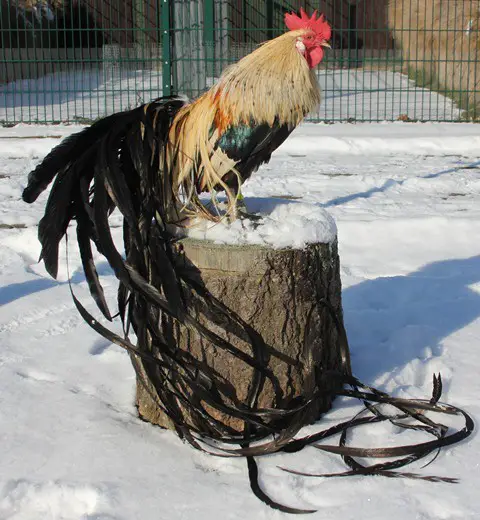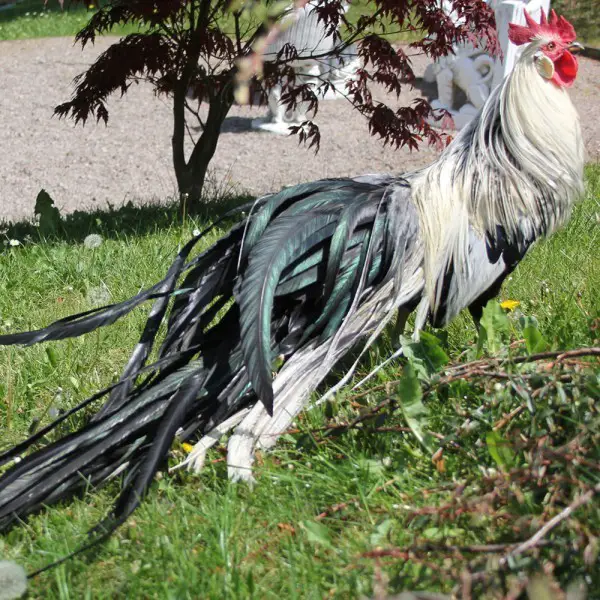There are some that say that the Onagadori Chicken is one of the most beautiful chickens in the world. You know what? It is pretty tough to argue with that statement. This is a beautiful breed.
It is just a shame that the vast majority of us are never going to come into contact with this beautiful long-tailed chicken breed. Let’s take a look, shall we?
Facts at a Glance
| Eggs | 50 +/- per year |
| Egg Shell Color | Light brown |
| Recognized Variety | Black-breasted white, Black-breasted red, White |
| Use | Show/Ornamental |
| Skin Color | Yellow |
| Comb Type | Single |
| Weight | Male: 4 lb. (1.8 kg) Female: 3 lb. (1.35 kg) |
| Country of origin | Japan |
| Admitted to APA | Not recognized breed in US |
| Status | Endangered |
The Origins of the Onagadori Chicken
The history of this chicken breed can be traced all the way back to Germany. We are talking centuries here. This is because the Onagadori chicken has the blood of a German Phoenix chicken in it. However, the European history of the bird ends here.
This is a Japanese breed through and through. It is found in the Tosa Province of Japan, and here it has been bred for the last 400-years.
Surprisingly, this is not a breed that you can find anywhere else in the world. It is only ever found in Japan. This is why we told you that you would likely never come into contact with this breed.

The Onagadori chicken is a chicken that holds a special place in the hearts of the Japanese people too. It is one of the ‘special’ birds to the country.
It is the only chicken to hold this status, although they do hold 16 other breeds of chicken in high regard.
Sadly, this is a breed of chicken that probably isn’t going to be around for too long.
This is because there are only a couple of hundred chickens left in existence, and these are spread out around just 12 different breeders. While we are positive that the breeders of the Onagadori chicken are going to do their absolute best
Do You Want Big Beautiful Eggs?
Then you must check this ORGANIC & NON-GMO feed. Our hens lay jumbo eggs now and they love this feed! You can check it right here on Amazon.
The Look of the Onagadori Chicken
There is a lot going on with this breed of chicken. However, the main focus for raising this breed has always been to get the tail feathers as long as possible.
Now, the Onagadori chicken is a very elegant breed. However, it has a trait that most other chicken breeds do not have.
This is the fact that their tail feathers do not molt. They can do, but the breeders that raise these chickens will work their hardest to ensure that they don’t. Because these tail feathers do not molt, they just continue to grow and grow.
Therefore, it isn’t uncommon to see an Onagadori chicken with tail feathers that are 16 – 32 feet (5-10 meters) long.
Unfortunately, this Japanese longtail chicken is not recognized breed in US by APA.
The Onagadori chicken is available in three different colors:
- Red with black breasts
- White with black breasts
- Purely white
No matter which color combination, the chicken will always have white earlobes. These will be combined with a beautiful and prominent single comb.
As a Show Chicken
The Onagadori chicken is only ever raised as a show breed. Yep. Even though this breed only has 12 breeders raising it, they compete a lot on the show front.
This is because it is a special bird in Japan, and it is probably quite lucrative to have the best-looking bird out of all of them!

A lot of these breeders will sell their chicken stock to people that are looking for an ornamental breed of chicken. However, those people won’t really be raising the chicken themselves.
They will just be using them for decorative purposes, and maybe a couple of eggs, for the few years that the chicken lives. Although, it is worth pointing out that once they head out into a yard, the chances of them keeping their long tail feathers isn’t going to be that high.
Onagadori Chicken For Eggs and Meat
While it is likely that the chickens that do not quite meet show quality are turned into meat birds, they are never going to be raised as a meat chicken breed.
The lack of focus on that when it came to developing this breed means that they would never make a good meat bird.
Fully grown Onagadori rooster weighs 4 lb. and a hen up to 3 lb. – there isn’t enough meat on them!
Once again, this chicken is not used for anything other than ornamental purposes. As a result, it is not going to be a decent egg layer too.
It seems that the majority of people have focused on raising this breed for the sole purpose of making it look good. The other traits of a chicken will suffer.
Now, obviously, this is a chicken breed that is going to lay eggs. It needs to lay eggs otherwise it would be dying out pretty quickly. However, it is going to be rare that these eggs are actually eaten.
They are almost certainly only going to be used for those that want to breed the chicken.
Raising the Onagadori Chicken
Since, unless you live in a specific region of Japan, you are unlikely to ever raise Onagadori chicken yourself, it makes no sense us telling you how you should be raising it. Instead, we want to tell you how the Onagadori chicken breeders raise it.
As we said before, this is a breed that is famed for the beautiful tail feathers that they have. If the chicken is raised well, then these tail feathers will continue to grow.
However, it is imperative that the tail feathers are protected. As a result, a lot of these chickens are not actually raised on the ground.
This would mess up their feathers quite a bit. Instead, the chickens have had special coops designed for them where they live. This means that they have a perch where they do not run the risk of messing up their feathers at all.
In order to help ensure that the tails stay in a brilliant condition, the breeders of these chickens also put a lot of effort into ensuring that conditions are strictly controlled.
Moreover, in order to grow such a long tail feathers, these longtail chicken breeds need a high-protein diet.
Again, this is another reason why they are going to be kept mostly indoors. If they were let outside for long periods of time, then there is a strong chance they will end up losing their tail feathers.

